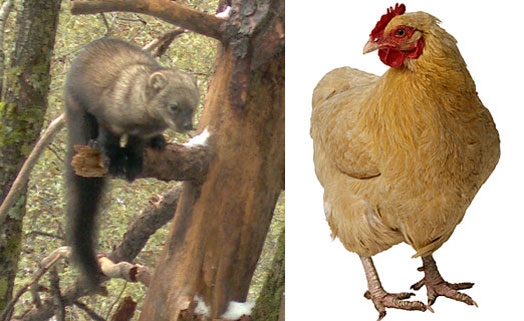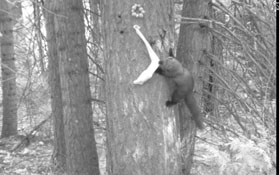Posts Tagged: Pacific fisher
Calendar with rare Pacific fisher photos available from UC Cooperative Extension
A treasure trove of candid Pacific fisher photos has been compiled into an 18-month calendar that is being sold to raise awareness about the small, nocturnal carnivore.
The calendars – designed by Anne Lombardo, a UC program representative with the Sierra Nevada Adaptive Management Project – are available for $12 each on the UCCE Central Sierra website.
Once widespread across the high elevation forests of the Sierra Nevada and in the coastal mountains of northwestern California, fishers are now found there only in two small isolated populations. One group lives near the California-Oregon border; the other in the southern Sierra Nevada between Yosemite and Sequoia national parks.
Two research studies of the southern fisher population – one led by the University of California in the Sugar Pine area south of Yosemite and the other led by the U.S. Forest Service in the Kings River watershed – have been documenting the fate of the animals for the past six years. During that time, forests were treated to reduce fire danger by thinning trees under 30 inches in diameter or by smashing down small trees and brush in a process called mastication. The research will determine whether the treatments have an impact on the fisher population. The Kings River project has been led by USFS research ecologist Craig Thompson since its inception. Thompson recently also took over leadership of the Sugar Pine project to complete the final two years.
In the Yosemite area, most of the fisher surveillance has been done by plane using radio telemetry to track fisher with transmitting collars. In the Forest Service study area, the radio telemetry surveillance has been done on the ground.
“Now that we are working more closely together, we have access to many more pictures,” Lombardo said. “They have done a lot of tracking in this area and taken some incredible photos.”
The calendar includes 20 photos of a creature that wildlife lovers rarely get to see because of the Pacific fishers' relatively small population and reclusive habits. Photos include kits with their mothers in the wild and also orphaned kits on their own at a wildlife recovery facility. The calendar marks the days between July 2014 and December 2015.
More information about the fisher projects in the Sierra Nevada may be found on the Sierra Nevada Adaptive Management Project website.
Roadkill is a serious threat to rare wildlife populations
Why shouldn’t the chicken cross the road? Because statistics show it is very likely she will be run over! According to the Humane Society of the United States, over a million animals die on our roads every day.
Wildlife statistics gathered by the California Roadkill Observation System created by the Road Ecology Center at UC Davis have recorded almost 22,000 animal deaths on California roads in the last four years. Roads are an additional danger beyond those that Mother Nature already has in store for the wildlife of our state and it is one we bear the responsibility for. The loss of each animal affects its population numbers, it reproductive capacity and any babies left behind in its nests. But if an animal does not cross roads, it can result in genetic isolation in wildlife populations and loss of habitat.
For the Pacific fisher research team of the Sierra Nevada Adaptive Management Project (SNAMP), roadkill is very much a concern. They have been tracking the Pacific fisher, a nocturnal forest dwelling weasel, in the southern Sierra for the last five years. Their goal has been to identify the effects that forest thinning in may have on the fisher. In their careful tracking, they have recorded the deaths of nine of these rare animals on Highway 41, which cuts through the study area on its way to Yosemite. This is an important number considering the isolated population is estimated to be only about 300 individuals south of the Merced River; and these are only the roadkill incidents we know about.
In the team’s search for solutions to the roadkill issue, they have assembled a Wildlife-Vehicle Collision Group with the Forest Service, Yosemite National Park, Defenders of Wildlife and Caltrans to search for any possible solutions. Members of the SNAMP Wildlife Team put cameras in culverts passing beneath Highway 41 from Oakhurst to Yosemite to see if they were being used as a possible alternate route. (For details see the Sierra Nevada Highway Culvert Product, pdf). The good news is that many animals, including fisher, were found to be using road culverts to pass beneath the road, avoiding collisions with cars. This provides some hope that maintenance of the entrances and exits of existing culverts offers a safe alternative to road crossing for wildlife.
UC's 'viral' sock drive appears on the Bee's front page
Who would have thought old socks could drive a media storm? A call from participants in UC's Sierra Nevada Adaptive Management Project for donations of gently used socks for Pacific fisher research generated a flurry of response, and now the overwhelming public response resulted in a front-page story in the Sacramento Bee. The article also ran on the front page of the Fresno Bee.
Bee writer Matt Weiser reported that bulging padding envelopes and duct-taped boxes filled with socks trickled in at first. In time, boxes of socks from Girl Scout troops and elementary schools forced the researchers to wheel their mail from the post office in carts.
"We basically generated several truckloads," said UC Berkeley associate adjunct professor Rick Sweitzer. "It was incredible."
Sweitzer said Weiser had called him last week to ask about porcupines in California. Weiser said he and his wife had sent socks themselves last December. When he heard about the unexpected outpouring of socks, he turned his immediate attention to telling that story.
UC wildlife research team seeks single socks
The team is part of the Sierra Nevada Adaptive Management Project (SNAMP), which is examining the effects of forest thinning, as currently done by the U.S. Forest Service, on the health of local wildlife, the forest and water resources. The U.S. Forest Service implements these thinning treatments out of concern for excessive fire risk.
But what kind of research could go through hundreds of socks a month? After years of experimentation, the research team has determined that socks are the ideal receptacle for hanging fisher bait in trees. The baited socks are hung in trees in view of motion-activated cameras. As the animal moves, climbing the tree and chewing on the sock, the camera takes photos that allow the scientists to identify the species.
The researchers are going through 250 pairs a month, at a considerable cost, to create the “chicken in a sock” bait stations to survey the distribution of Pacific fishers in a 500-square-mile area of forest near Bass Lake.
Besides the cost, Rick Sweitzer, UC Berkeley wildlife biologist and project leader. is spending time in the Wal-Mart checkout line with a cart full of socks when he could be doing research. The scientists don’t need new socks; they would prefer old, unmatched, non-holey ones,something everyone has cluttering up their sock drawers.
In an effort to reduce, reuse and recycle, the SNAMP wildlife research team is
putting out a call for lost and lonely socks. Socks may be delivered or mailed
to 40799 Elliott Dr., Oakhurst CA 93644.
The Pacific fisher is a small, nocturnal carnivore that perches and dens in large,
old-growth pine and oak trees. Once widespread across the high elevation
forests of the Sierra Nevada and in the coastal mountains of northwestern
California, fishers are now only found in two small isolated populations. One
group lives near the California-Oregon border. The others are in the southern
Sierra Nevada.
Data being collected by UC scientists about the movements, habitat preferences and
survival of fishers in the southern Sierra Nevada will be used to aid the
multiple agencies, academic institutions, environmental groups, and mountain
residents who are working together to ensure that long-term wildland management
promotes forest health, wildfire control and wildlife conservation.
For more information, contact Anne Lombardo at amlombardo@ucdavis.edu.
To read more about the research project visit the SNAMP website at http://snamp.cnr.berkeley.edu.
###
EDITORS: A photo of a Pacific fisher grabbing a bait-filled
sock can be downloaded from http://ucanr.org/blogs/Green.
Two animal updates in the Merced Sun-Star
News about animals under study in distinct branches of UC Agriculture and Natural Resources were featured recently in the Merced Sun-Star. A female Pacific fisher being tracked in the Sierra Nevada by UC Berkeley scientists has established a den within Yosemite National Park, the paper reported. Meanwhile, UC Davis scientists are joining in research with Michigan State University to study the housing of egg-laying hens, another story said.
Researchers with the Sierra Nevada Adaptive Management Program Fisher Project track fishers, endangered members of the weasel family, using radio-telemetry. The Yosemite fisher was first captured in October 2009 in the Sierra National Forest and remained near the capture site for nearly a year. Recently, the fisher moved her kits to a den on the south side of Yosemite.
This is the first fisher that is part of the study to make a home within park boundaries.
In the chicken story, the newspaper reported that UC Davis and Michigan State received $6 million for the study from the Coalition for Sustainable Egg Supply, a group made up mostly of egg producers, purchasers and universities with major agriculture programs.
The research will compare three approaches to chicken housing:
- Conventional cage housing, now used by most U.S. egg producers.
- Enriched cage housing, larger than conventional cages and equipped with perches, nesting areas and foraging/dust-bathing materials.
- Cage-free aviary, a non-cage system that enables hens to roam along a building's floor level and have access to perches and nest boxes.
"The information gained will be useful to all consumers as they make decisions about what kinds of eggs to buy," the story quoted Joy Mench, a UC Davis animal science professor and director of the Center for Animal Welfare.

Pacific fisher, left, dens in Yosemite. UC Davis launches chicken housing study.




